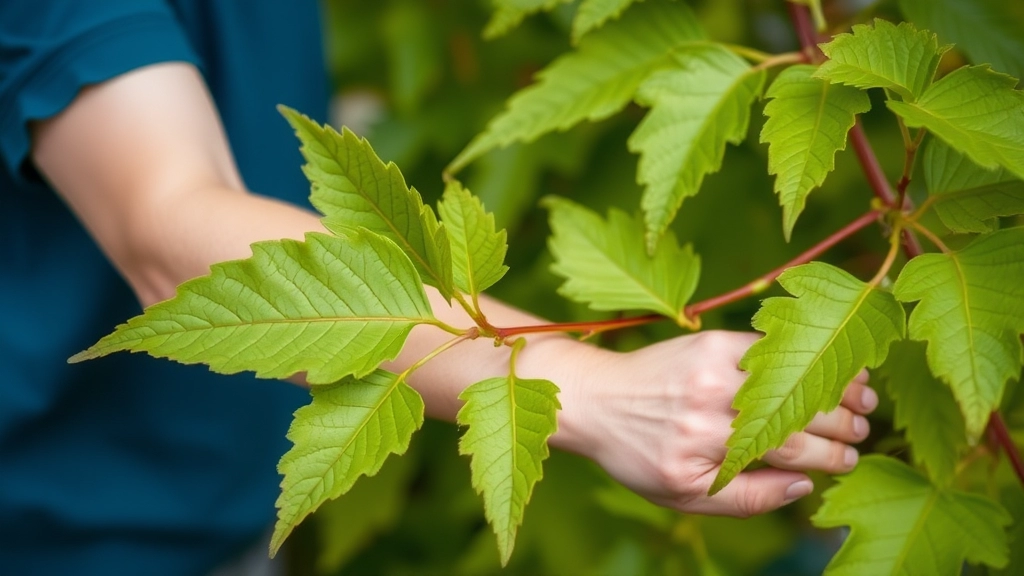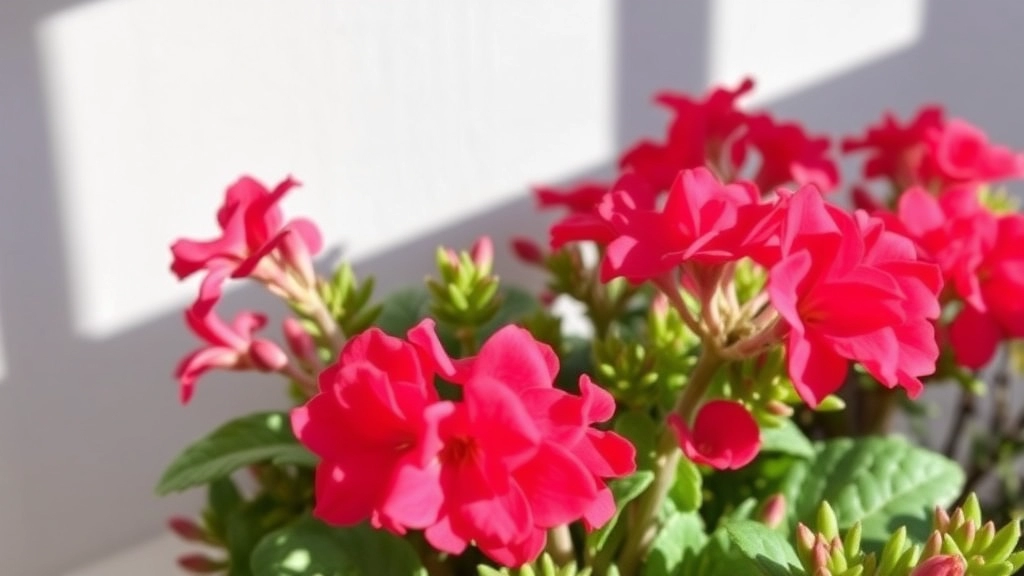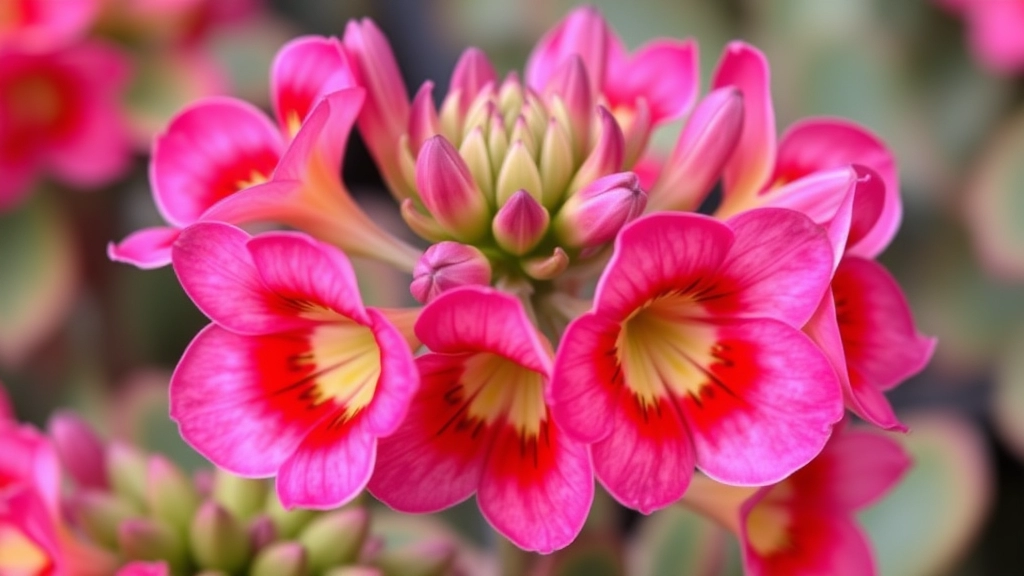Understanding Etiolation in Kalanchoe Blossfeldiana
As a passionate plant enthusiast, I’ve seen my fair share of etiolated Kalanchoe blossfeldiana, and I’m here to share my insights. In this article, we’ll explore the causes, symptoms, and solutions for this common issue that affects these beautiful succulents. From insufficient light to improper care, we’ll cover it all.
Whether you’re a seasoned gardener or a beginner, understanding etiolation in Kalanchoe blossfeldiana is crucial for maintaining healthy, vibrant plants. We’ll dive into prevention strategies, proper lighting conditions, and even steps to revive an etiolated plant. Get ready to become a Kalanchoe expert and say goodbye to leggy, stretched-out plants!
Causes of Etiolation in Kalanchoe Blossfeldiana
Ever wondered why your Kalanchoe’s looking a bit… stretched out?
Let’s chat about etiolation – it’s not as scary as it sounds, promise!
What’s the deal with etiolation?
Etiolation is plant-speak for “I’m not getting enough light, help!”
It’s like when you’re reaching for that last biscuit on the top shelf – your Kalanchoe’s doing the same, but for sunlight.
The main culprit: Insufficient light
Your Kalanchoe’s crying out for more rays.
These sun-lovers need bright, indirect light to thrive.
Without it, they go all leggy and weak – not a good look!
Other factors that can cause etiolation:
- Overcrowding: Too many plants, not enough light to go around
- Wrong spot: Maybe it’s tucked away in a dark corner
- Seasonal changes: Winter can be tough on these guys
- Overwatering: Yep, too much water can mess with light absorption
How to spot it early:
- Pale, yellowish leaves
- Longer stems between leaves
- Smaller leaves than usual
- Weak, floppy growth
Remember, prevention’s better than cure.
Keep an eye on your Kalanchoe and give it the light it craves.
Trust me, your plant will thank you for it!
Identifying Symptoms of Etiolation

Let’s dive into spotting etiolation in your Kalanchoe Blossfeldiana. Trust me, it’s not rocket science, but it’s crucial to catch it early.
What’s the deal with etiolation?
Etiolation is basically your plant screaming, “I need more light!” It’s like when you’re stuck in a dark room and start feeling all pale and lanky. Same for your Kalanchoe.
Here’s what to look out for:
- Stretchy stems: Your plant’s reaching for the sky, but not in a good way. The stems get long and weak.
- Pale leaves: The usual vibrant green turns into a sad, washed-out version.
- Bigger gaps between leaves: It’s like your plant’s playing social distancing with its own leaves.
- Smaller new leaves: Any new growth looks puny compared to the older leaves.
- Leaning towards light: Your Kalanchoe’s doing yoga, bending towards the nearest light source.
I once had a Kalanchoe that looked like it was trying to escape its pot. Turns out, it was just desperate for some sun. Don’t let yours get to that point!
Why should you care?
Catching etiolation early means you can fix it before your plant turns into a sad, floppy mess. Plus, a healthy Kalanchoe is a blooming Kalanchoe, and who doesn’t want those gorgeous flowers?
Remember, etiolation in Kalanchoe Blossfeldiana isn’t a death sentence. It’s just your plant’s way of saying it needs a change. In the next section, we’ll chat about how to prevent this from happening in the first place. Stay tuned!
Preventing Etiolation in Indoor Settings
Hey there, plant pals! Let’s chat about keeping your Kalanchoe Blossfeldiana happy indoors.
Preventing etiolation is all about giving your plant the light it craves. Here’s how we do it:
1. Find the perfect spot
- Near a south-facing window is ideal
- East or west-facing windows work too
- Avoid north-facing windows (not enough light)
2. Rotate regularly
- Give it a quarter turn every week
- This ensures all sides get equal light
3. Artificial lighting
- Use grow lights if natural light is scarce
- LED or fluorescent lights work great
- Keep lights on for 12-14 hours daily
4. Watch the distance
- Keep plants within 6-12 inches of light sources
- Adjust based on your plant’s response
5. Mind the seasons
- Move plants closer to windows in winter
- Use sheer curtains in summer to filter harsh light
Pro tip: Get a light meter app on your phone. It’s like having a secret weapon!
Remember, prevention is easier than cure. Keep an eye on your Kalanchoe and adjust as needed.
Got any tricks you use to keep your indoor plants thriving? Share ’em in the comments!
Next up: Let’s dive into the perfect lighting conditions for our Kalanchoe friends.
Proper Lighting Conditions for Kalanchoe Blossfeldiana

Let’s talk about getting the lighting right for your Kalanchoe Blossfeldiana. Trust me, I’ve been there – struggling to keep these beauties happy and thriving. But once you nail the light, it’s game on!
So, what’s the deal with Kalanchoe and light?
These succulents are sun-lovers, but they’re not beach bums. They need bright, indirect light to really shine. Think of it like this: they want to be at a sunny outdoor café, but under the umbrella, not baking in the direct sun.
Here’s the lowdown on lighting up your Kalanchoe’s life:
- Aim for 6-8 hours of bright, indirect light daily
- South or west-facing windows are your best bet
- If you’re in a darker spot, consider grow lights to supplement
But here’s the kicker – too much direct sun can scorch those lovely leaves. It’s like giving your plant a nasty sunburn. Not cool.
On the flip side, not enough light and you’ll end up with a leggy, stretched-out plant that’s desperately reaching for more light. Been there, done that, and it’s not a good look.
So how do you know if your Kalanchoe’s getting enough light?
Look for these signs:
- Compact growth
- Vibrant, colourful flowers
- Leaves that are a healthy green, not pale or yellowing
If you’re seeing any of these, pat yourself on the back – you’re nailing it!
But what if you’re stuck in a dim corner or a north-facing window? Don’t sweat it. Grow lights can be a game-changer. They’re not just for hardcore plant nerds anymore – there are tons of stylish options that’ll blend right in with your decor.
Remember, getting the light right for your Kalanchoe Blossfeldiana is key to avoiding etiolation and keeping your plant happy and healthy. It might take a bit of trial and error, but once you find that sweet spot, your Kalanchoe will thank you with gorgeous blooms and lush growth.
Steps to Revive an Etiolated Kalanchoe Blossfeldiana
So, your Kalanchoe’s looking a bit stretched out and sad. No worries, we’ve all been there.
Let’s get that plant back in shape, shall we?
Light is Key
First things first, light is your best friend here.
Move that baby to a brighter spot, but easy does it. Sudden changes can shock the plant.
Gradual is the name of the game.
Trim Those Leggy Stems
Now, about those leggy stems. Time for a haircut.
Grab some clean, sharp scissors and trim those stems back by about a third.
It might look a bit brutal, but trust me, your Kalanchoe will thank you later.
Don’t chuck those cuttings! They’re gold for propagation.
Soil and Water
Next up, let’s talk soil. Is it looking a bit tired?
Time for a refresh. Get some well-draining potting mix and give your plant a new home.
Watering’s crucial too. But here’s the kicker – less is more.
Let the soil dry out between waterings. These succulents hate wet feet.
Feeding and Patience
Feeding time! A balanced, water-soluble fertiliser will do the trick.
But go easy. Half-strength is plenty.
Patience is key here. Your Kalanchoe won’t bounce back overnight.
Give it time, keep an eye on it, and before you know it, you’ll have a bushy, healthy plant again.
Remember, prevention’s better than cure. Keep these tips in mind for future care, and you’ll avoid etiolation altogether.
Common Mistakes in Caring for Kalanchoe Blossfeldiana

Let’s chat about Kalanchoe Blossfeldiana, shall we? I’ve seen folks make some real blunders with these beauties, and I’m here to spill the tea on what not to do.
Overwatering: The Silent Plant Killer
First up, overwatering. It’s like drowning your plant in kindness. These succulents are tough cookies and don’t need as much water as you might think. I’ve learned the hard way that less is more when it comes to watering Kalanchoes.
- Water only when the top inch of soil feels dry
- Ensure proper drainage to avoid root rot
- Cut back on watering during winter months
Poor Lighting: A Recipe for Etiolation
Next on the hit list? Poor lighting. Kalanchoes love their sun, and skimping on light is a surefire way to end up with a leggy, stretched-out plant. Trust me, I’ve seen it happen more times than I can count.
- Place your Kalanchoe in a spot with bright, indirect light
- Rotate the plant regularly for even growth
- Consider artificial lighting if natural light is limited
Ignoring Temperature Needs
Here’s a mistake I used to make: forgetting that Kalanchoes have temperature preferences. These plants aren’t fans of extreme cold or heat.
- Keep temperatures between 15-21°C (60-70°F)
- Avoid placing near drafty windows or heating vents
- Protect from frost if kept outdoors
Fertiliser Faux Pas
Overfeeding or underfeeding – both are common mistakes. It’s like trying to bulk up your plant with protein shakes when all it needs is a balanced diet.
- Use a balanced, water-soluble fertiliser monthly during growing season
- Reduce or stop fertilising in winter
- Don’t fertilise immediately after repotting
Neglecting Pruning
Lastly, forgetting to prune. It’s like never getting a haircut – things can get wild and unruly fast.
- Regularly remove dead or yellowing leaves
- Pinch back stems to encourage bushier growth
- Prune after flowering to maintain shape
Remember, caring for Kalanchoe Blossfeldiana isn’t rocket science, but it does require some know-how. Avoid these common mistakes, and you’ll be well on your way to having a thriving, beautiful plant. Keep it simple, keep it consistent, and your Kalanchoe will thank you for it.
Best Practices for Healthy Growth
Let’s chat about keeping your Kalanchoe Blossfeldiana thriving, shall we?
First things first: light is king.
These succulents love bright, indirect sunlight. Think of it as a sweet spot between full sun and shade.
Water? Less is more.
Overwatering is a rookie mistake. Let the soil dry out between waterings.
Speaking of soil, well-draining is the way to go.
Mix in some perlite or sand to your potting mix. Your Kalanchoe will thank you.
Feeding time!
During growing season, a monthly dose of balanced fertilizer does wonders.
Temperature matters too.
These guys prefer it warm, around 15-25°C (59-77°F).
Pruning isn’t just for looks.
Regular trimming encourages bushier growth and more blooms.
Repotting? Only when necessary.
Every 2-3 years should do the trick.
Humidity isn’t a big deal.
Kalanchoe can handle average room humidity like a champ.
Watch out for pests.
Keep an eye out for mealybugs and spider mites. Early detection is key.
Remember, consistency is your best friend when it comes to Kalanchoe care.
Stick to these best practices, and you’ll have a happy, healthy plant in no time.
Seasonal Care Tips for Kalanchoe Blossfeldiana
Let’s chat about keeping your Kalanchoe Blossfeldiana happy all year round, shall we? These little beauties need different TLC depending on the season, and I’ve got some no-nonsense tips to help you out.
Spring: Wakey-Wakey Time
- Kick-start growth with a balanced fertiliser
- Gradually increase watering as days get longer
- Prune any leftover winter damage
Summer: Sun’s Out, Fun’s Out
Here’s the deal: Kalanchoes love summer, but too much of a good thing can be, well, not so good.
- Move to a spot with bright, indirect light
- Water more frequently, but don’t go overboard
- Watch out for sunburn on those leaves
Autumn: Prepping for the Chill
As the days get shorter, your Kalanchoe’s gonna need some adjustments:
- Reduce watering gradually
- Stop fertilising
- Move to a cooler spot to encourage blooming
Winter: Cosy Time
This is when your Kalanchoe really shows off, but it needs your help:
- Keep it warm (around 15-21°C is perfect)
- Water sparingly – once every 2-3 weeks should do
- Provide bright light, but no direct sun
Remember, these are just guidelines. Your Kalanchoe might need tweaks based on your specific environment. The key is to pay attention and adjust as needed.
Quick Tip: If you’re struggling with etiolation in your Kalanchoe, check out our guide on “Identifying Symptoms of Etiolation” for some handy pointers.
Bottom line: Seasonal care for Kalanchoe Blossfeldiana isn’t rocket science. Just keep an eye on the changing conditions and adjust your care routine accordingly. Your plant will thank you with gorgeous blooms and healthy growth all year round.
FAQs: Etiolated Kalanchoe Blossfeldiana
Q: What exactly is etiolation in Kalanchoe Blossfeldiana?
A: Etiolation is a plant’s response to insufficient light. In Kalanchoe Blossfeldiana, it manifests as elongated stems, pale leaves, and weak growth. It’s essentially the plant stretching out in search of more light.
Q: How can I tell if my Kalanchoe is etiolated?
A: Look for signs like unusually long, thin stems, larger gaps between leaves, and overall pale or yellowish coloration. If your plant is leaning towards a light source, that’s another clear indicator.
Q: Can an etiolated Kalanchoe recover?
A: Yes, absolutely! With proper care, including increased light exposure and some pruning, your Kalanchoe can bounce back. However, the elongated growth won’t revert, so you may need to trim and reshape the plant.
Q: How much light does a Kalanchoe Blossfeldiana need to prevent etiolation?
A: Kalanchoe Blossfeldiana thrives in bright, indirect light for about 6-8 hours daily. A south or west-facing window is ideal, but be careful of harsh afternoon sun which can scorch the leaves.
Q: Is it okay to use artificial light for my Kalanchoe?
A: Absolutely! If natural light is limited, grow lights can be an excellent supplement. LED or fluorescent lights work well, placed about 6-12 inches from the plant for 12-14 hours a day.
Q: How often should I water my Kalanchoe to keep it healthy?
A: Less is more when it comes to watering Kalanchoe. Allow the top inch of soil to dry out between waterings. In winter, you might only need to water every 2-3 weeks.
Q: Can etiolation affect my Kalanchoe’s blooming?
A: Yes, etiolation can significantly impact flowering. A stretched-out, weak plant often struggles to produce blooms. Ensuring proper light and care will promote healthier growth and more abundant flowering.
Q: Should I fertilize my etiolated Kalanchoe?
A: While addressing the light issue is primary, a balanced, water-soluble fertilizer can help support recovery. Use it at half strength monthly during the growing season, but avoid fertilizing in winter.
References
-
Kalanchoe Blossfeldiana Care Guide Growing Kalanchoe Plants: Care Of Kalanchoe Houseplants

